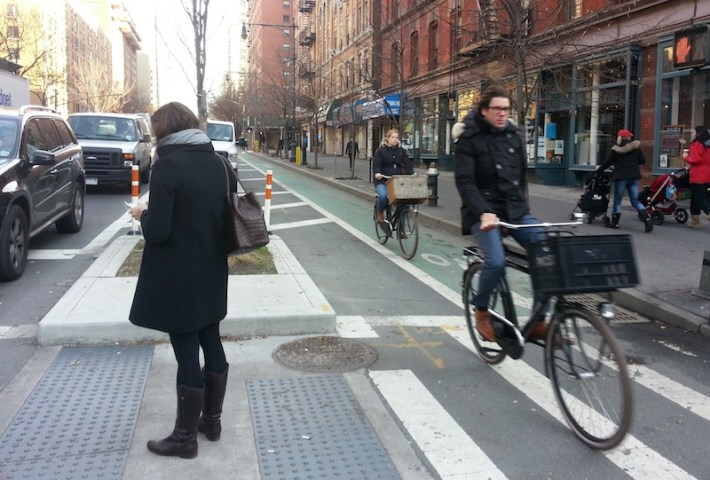This morning, WNYC's Brian Lehrer discussed the Columbus Avenue bike lane with reporter Kate Hinds. The show covered a fair amount of ground in a short amount of time, but gave a lot of airtime to a key assumption which has given cover to street safety opponents -- that small retailers in New York City need to maintain as much on-street parking as possible -- and let it go unchallenged for much of the segment.
"The main sticking point of whether the bike lane hurts small businesses led to a tie vote" at committee, Lehrer said in his introduction, though the main factor was the predictable opposition from a pair of committee chairs who reflexively block measures as simple as adding sidewalk bike racks.
Hinds added that "the loss of parking spaces is a continual sticking point" which "throws small retailers into a tizzy." But it wasn't until the very end of the segment that she mentioned the Columbus Avenue BID's 100 percent occupancy rate and the fact that the bike lane definitely isn't hurting businesses south of 82nd Street.
There's plenty of other data out there showing that retailers in a transit-rich, walkable neighborhood like the Upper West Side benefit from bike- and pedestrian-friendly street redesigns, which WNYC could have referred to when discussing the demonstrably false assumption that these businesses rely on customers who drive up and shop.
Some of the most recent and thorough research comes from a study of sales tax receipts, commercial rents, and property tax assessments in areas where streets have been redesigned to improve conditions for pedestrians and cyclists. The preliminary data published by NYC DOT consultant Bennett Midland showed that of 11 NYC retail corridors with recent street improvements, eight have bigger sales increases than nearby commercial streets and the borough-wide average. According to Bennett Midland's Eric Lee, “We can say in New York today that bicycle lanes, pedestrian improvements and plazas — the removal of travel lanes and parking — do not do damage” to retail sales.
Multiple surveys have revealed that merchants are poor judges of how their customers access their stores. In Vancouver, downtown merchants on streets where protected bike lanes have been installed also badly misjudged the percentage of their customers who arrived by car. In Toronto, merchants consistently overestimated the percentage of their customers who drive to go shopping.
Closer to home, intercept surveys reveal that driving shoppers are a very small percentage of the customer base for NYC retailers. Only 2 percent of people Project for Public Spaces surveyed walking past Columbus Avenue shops had driven there. Three out of every four Upper West Side households don't own a car.
The proof is in the pudding, yet the assumption that parking is paramount to New York City retailers persists. Next time the issue comes up on WNYC, hopefully they'll be quicker to challenge this red herring.






